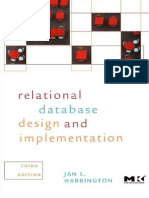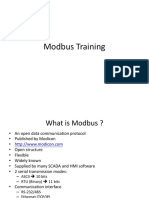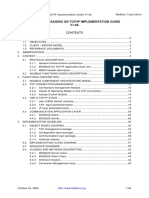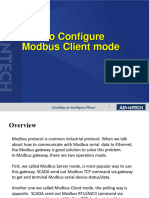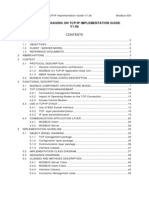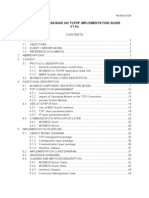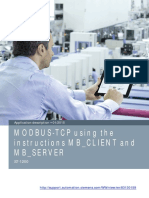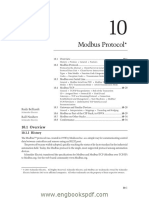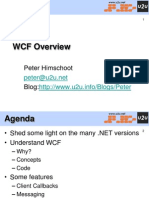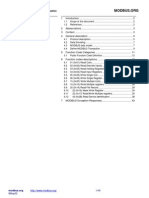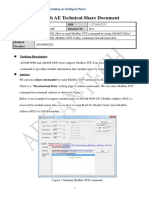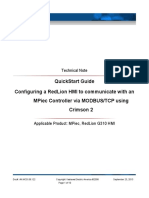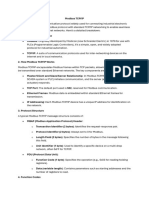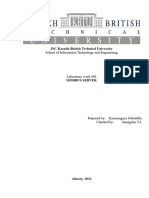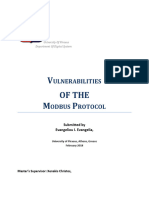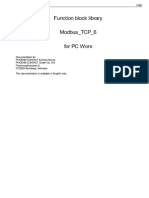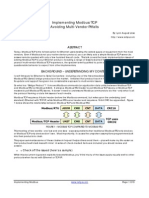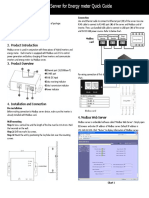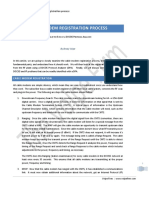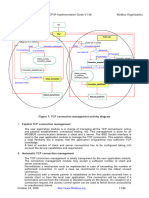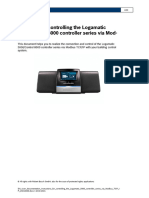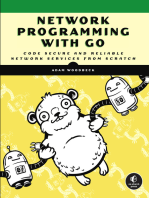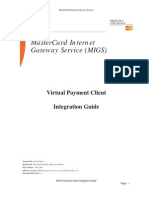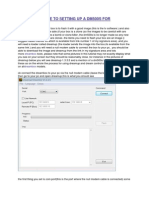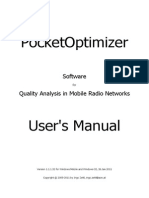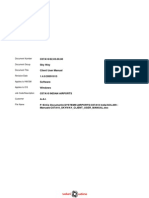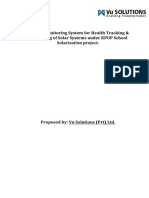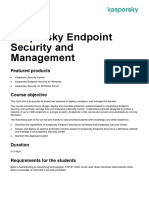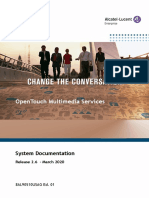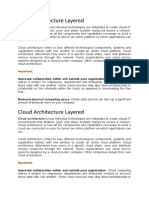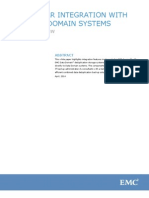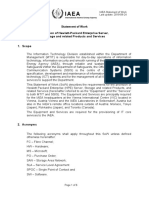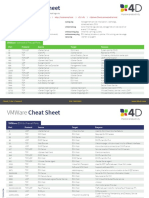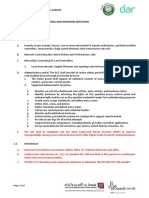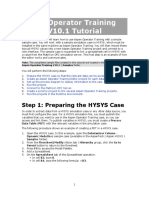Modbus 通信協定03
Modbus 通信協定03
Uploaded by
wenyuan.chenCopyright:
Available Formats
Modbus 通信協定03
Modbus 通信協定03
Uploaded by
wenyuan.chenOriginal Description:
Original Title
Copyright
Available Formats
Share this document
Did you find this document useful?
Is this content inappropriate?
Copyright:
Available Formats
Modbus 通信協定03
Modbus 通信協定03
Uploaded by
wenyuan.chenCopyright:
Available Formats
MODBUS Messaging on TCP/IP Implementation Guide V1.
0b Modbus Organization
Idle
Wait
[Reveive_Response_from_TCP_Mgt]
[Request_from_the_user application]
Waiting_response_timer_expires
Process Find out pending Build MODBUS
MODBUS transaction request
Confirmation
[Confirmation error] [Retries number not reached] Send MODBUS request
To TCP management
[Confirmation OK]
[Retries number reached]
Send positive
confirmation to [Send Not OK] [Send OK]
User Application
Send negative
confirmation to user Set Waiting
Application response timer
Figure 11: MODBUS Client Activity Diagram
A MODBUS client can receive three events:
A new demand from the user application to send a request, in this case a MODBUS
request has to be encoded and be sent on the network using the TCP management
component service. The lower layer ( TCP management module) can give back an
error due to a TCP connection error, or some other errors.
A response from the TCP management, in this case the client has to analyze the
content of the response and send a confirmation to the user application
The expiration of a Time out due to a non-response. A new retry can be sent on the
network or a negative confirmation can be sent to the User Application.
Remark : These retries are initiated by the MODBUS client, some other retries can
also be done by the TCP layer in case of TCP acknowledge lack.
4.4.1.2 Build a MODBUS Request
Following the reception of a demand from the user application, the client has to build a
MODBUS request and to send it to the TCP management.
Building the MODBUS request can be split in several sub-tasks:
The instantiation of a MODBUS transaction that enables the Client to memorize all
required information in order to bind later the response to the request and to send
the confirmation to the user application.
The encoding of the MODBUS request (PDU + MPAB header). The user application
that initiates the demand has to provide all required information which enables the
Client to encode the request. The MODBUS PDU is encoded according to the
MODBUS Application Protocol Specification [1]. (MB function code, associated
parameters and application data ). All fields of the MBAP header are filled. Then,
the MODBUS request ADU is built prefixing the PDU with the MBAP header
October 24, 2006 http://www.Modbus.org 21/46
MODBUS Messaging on TCP/IP Implementation Guide V1.0b Modbus Organization
The sending of the MODBUS request ADU to the TCP management module which is
in charge of finding the right TCP socket towards the remote Server. In addition to
the MODBUS ADU the Destination IP address must also be passed.
The following activity diagram describes, more deeply than in Figure 11 MODBUS
Client Activity Diagram, the request building phase.
Instantiate a MB
transaction
[No Transaction available]
[Transaction available]
Initialize the
transaction
Encode the MB
request PDU
Encode the
MBAP header
Send a Send MB
negative request to TCP
confirmation to Mgt
the user
application
Figure 12: Request building activity diagram
The following example describes the MODBUS request ADU encoding for reading the
register # 5 in a remote server :
♦ MODBUS Request ADU encoding :
Description Size Example
MBAP Header Transaction Identifier Hi 1 0x15
Transaction Identifier Lo 1 0x01
Protocol Identifier 2 0x0000
Length 2 0x0006
Unit Identifier 1 0xFF
October 24, 2006 http://www.Modbus.org 22/46
MODBUS Messaging on TCP/IP Implementation Guide V1.0b Modbus Organization
MODBUS Function Code (*) 1 0x03
request Starting Address 2 0x0004
Quantity of Registers 2 0x0001
(*) please see the MODBUS Application Protocol Specification [1].
• Transaction Identifier
The transaction identifier is used to associate the future response with the request.
So, at a time, on a TCP connection, this identifier must be unique. There are
several manners to use the transaction identifier:
- For example, it can be used as a simple "TCP sequence number" with a
counter which is incremented at each request.
- It can also be judiciously used as a smart index or pointer to identify a
transaction context in order to memorize the current remote server and the
pending MODBUS request.
Normally, on MODBUS serial line a client must send one request at a time. This means
that the client must wait for the answer to the first request before sending a second
request. On TCP/MODBUS, several requests can be sent without waiting for a
confirmation to the same server. The MODBUS/TCP to MODBUS serial line gateway is
in charge of ensuring compatibility between these two behaviors.
The number of requests accepted by a server depends on its capacity in term of
number of resources and size of the TCP windows. In the same way the number of
transactions initialized simultaneously by a client depends also on its resource capacity.
This implementation parameter is called "NumberMaxOfClientTransaction" and must
be described as one of the MODBUS client features. Depending of the device type this
parameter can take a value from 1 to 16.
• Unit Identifier
This field is used for routing purpose when addressing a device on a MODBUS+
or MODBUS serial line sub-network. In that case, the “Unit Identifier” carries the
MODBUS slave address of the remote device:
If the MODBUS server is connected to a MODBUS+ or MODBUS Serial Line
sub-network and addressed through a bridge or a gateway, the MODBUS Unit
identifier is necessary to identify the slave device connected on the sub-
network behind the bridge or the gateway. The destination IP address
identifies the bridge itself and the bridge uses the MODBUS Unit identifier to
forward the request to the right slave device.
The MODBUS slave device addresses on serial line are assigned from 1 to
247 (decimal). Address 0 is used as broadcast address.
On TCP/IP, the MODBUS server is addressed using its IP address; therefore, the
MODBUS Unit Identifier is useless. The value 0xFF has to be used.
When addressing a MODBUS server connected directly to a TCP/IP network,
it’s recommended not using a significant MODBUS slave address in the “Unit
Identifier” field. In the event of a re-allocation of the IP addresses within an
automated system and if a IP address previously assigned to a MODBUS
server is then assigned to a gateway, using a significant slave address may
cause trouble because of a bad routing by the gateway. Using a non-
significant slave address, the gateway will simply discard the MODBUS PDU
with no trouble. 0xFF is recommended for the “Unit Identifier" as non-
significant value.
Remark : The value 0 is also accepted to communicate directly to a
MODBUS/TCP device.
October 24, 2006 http://www.Modbus.org 23/46
MODBUS Messaging on TCP/IP Implementation Guide V1.0b Modbus Organization
4.4.1.3 Process MODBUS Confirmation
When a response frame is received on a TCP connection, the Transaction Identifier
carried in the MBAP header is used to associate the response with the original request
previously sent on that TCP connection:
If the Transaction Identifier doesn't refer to any MODBUS pending transaction, the
response must be discarded.
If the Transaction Identifier refers to a MODBUS pending transaction, the response
must be parsed in order to send a MODBUS Confirmation to the User Application
(positive or negative confirmation)
Parsing the response consists in verifying the MBAP Header and the MODBUS PDU
response:
MBAP Header
After the verification of the Protocol Identifier that must be 0x0000, the length gives
the size of the MODBUS response.
If the response comes from a MODBUS server device directly connected to the
TCP/IP network, the TCP connection identification is sufficient to unambiguously
identify the remote server. Therefore, the Unit Identifier carried in the MBAP
header is not significant (value 0xFF) and must be discarded.
If the remote server is connected on a Serial Line sub-network and the response
comes from a bridge, a router or a gateway, then the Unit Identifier (value != 0xFF)
identifies the remote MODBUS server which has originally sent the response.
MODBUS Response PDU
The function code must be verified and the MODBUS response format analyzed
according to the MODBUS Application Protocol:
• if the function code is the same as the one used in the request, and if the
response format is correct, then the MODBUS response is given to the user
application as a Positive Confirmation.
• If the function code is a MODBUS exception code (Function code + 80H), the
MODBUS exception response is given to the user application as a Positive
Confirmation.
• If the function code is different from the one used in the request (=non
expected function code), or if the format of the response is incorrect, then an
error is signaled to the user application using a Negative Confirmation.
Remark: A positive confirmation is a confirmation that the command was received and
responded to by the server. It does not imply that the server was able to successfully
act on the command (failure to successfully act on the command is indicated by the
MODBUS Exception response).
The following activity diagram describes, more deeply than in Figure 11 MODBUS
Client Activity Diagram, the confirmation processing phase.
October 24, 2006 http://www.Modbus.org 24/46
MODBUS Messaging on TCP/IP Implementation Guide V1.0b Modbus Organization
Find Out pending
MB transaction
[PendingTransaction ]
[No Pending Transaction ]
Use MB transaction to
bind with the request
Discard
Response
Analyse MBAP header
[Modbus_protocol] [Other_protocol]
Analyse Response
PDU
[MB response OK]
[Incorrect Response]
Send negative
[MB Exception response] Confirmation to
user Application
Extract MB Process_MB_
Response exception
Send positive
confirmation to user
application
Wait
Figure 13: Process MODBUS Confirmation activity diagram
4.4.1.4 Time-out management
There is deliberately NO specification of required response time for a transaction over
MODBUS/TCP.
This is because MODBUS/TCP is expected to be used in the widest possible variety of
communication situations, from I/O scanners expecting sub-millisecond timing to long
distance radio links with delays of several seconds.
From a client perspective, the timeout must take into account the expected transport
delays across the network, to determine a ‘reasonable’ response time. Such transport
delays might be milliseconds for a switched Ethernet, or hundreds of milliseconds for a
wide area network connection.
In turn, any ‘timeout’ time used at a client to initiate an application retry should be
larger than the expected maximum ‘reasonable’ response time. If this is not followed,
there is a potential for excessive congestion at the target device or on the network,
which may in turn cause further errors. This is a characteristic, which should always be
avoided.
October 24, 2006 http://www.Modbus.org 25/46
MODBUS Messaging on TCP/IP Implementation Guide V1.0b Modbus Organization
So in practice, the client timeouts used in high performance applications are always
likely to be somewhat dependent on network topology and expected client performance.
Applications which are not time critical can often leave timeout values to the normal
TCP defaults, which will report communication failure after several seconds on most
platforms.
4.4.2 MODBUS Server
Modbus
Client
Serial Line
Modbus Modbus
Client Client
Client TCP/IP
TCP/IP TCP/IP
gateway
Modbus TCP / IP
Modbus Modbus
Modbus Modbus
Server Server
Server Server
Serial Line Serial Line
TCP/IP TCP/IP Server TCP/IP
gateway
Modbus Serial line
Figure 14: MODBUS Server unit
The role of a MODBUS server is to provide access to application objects and services
to remote MODBUS clients.
Different kind of access may be provided depending on the user application :
simple access like get and set application objects attributes
advanced access in order to trigger specific application services
The MODBUS server has:
To map application objects onto readable and writable MODBUS objects, in order
to get or set application objects attributes.
To provide a way to trigger services onto application objects.
In run time the MODBUS server has to analyze a received MODBUS request, to
process the required action, and to send back a MODBUS response.
Informative Note: The application objects and services of the Backend Interface obtain
the requested data based upon the function code, and the User is responsible.
October 24, 2006 http://www.Modbus.org 26/46
MODBUS Messaging on TCP/IP Implementation Guide V1.0b Modbus Organization
4.4.2.1 MODBUS Server Design
The MODBUS Server design depends on both :
the kind of access to the application objects (simple access to attributes or
advanced access to services)
the kind of interaction between the MODBUS server and the user application
(synchronous or asynchronous).
The following activity diagram describes the main treatments that are processed by the
Server to obtain a MODBUS request from TCP Management, then to analyze the
request, to process the required action, and to send back a MODBUS response.
Idle
[Server init]
[Response from user application]
Wait
[Invocation user application done]
[MB Indication discarded] [Reception of a MODBUS indication
from TCP Mgt]
Invoke back [MB transaction refused] MODBUS_PDU_Checking...
end interface
[MODBUS transaction accepted]
[Processing not complete]
[Need user application processing] MODBUS_Service_Processing
Response
processing
[Processing not OK]
[Processing not OK]
[Processing OK] [Processing OK]
Build a MODBUS Build a MODBUS
Exception response
[MB Exception OK] [MB Response OK]
Send response
to TCP_Mgt
[processing ends] Release the
MODBUS server
transaction
Figure 15: Process MODBUS Indication activity diagram
October 24, 2006 http://www.Modbus.org 27/46
MODBUS Messaging on TCP/IP Implementation Guide V1.0b Modbus Organization
As shown in the previous activity diagram:
Some services can be immediately processed by the MODBUS Server itself, with
no direct interaction with the User Application ;
Some services may require also interacting explicitly with the User Application to
be processed ;
Some other advanced services require invoking a specific interface called
MODBUS Back End service. For example, a User Application service may be
triggered using a sequence of several MODBUS request/response transactions
according to a User Application level protocol. The Back End service is
responsible for the correct processing of all individual MODBUS transactions in
order to execute the global User Application service.
A more complete description is given in the following sections.
The MODBUS server can accept to serve simultaneously several MODBUS requests.
The maximum number of simultaneous MODBUS requests the server can accept is one
of the main characteristics of a MODBUS server. This number depends on the server
design and its processing and memory capabilities. This implementation parameter is
called "NumberMaxOfSeverTransaction" and must be described as one of the
MODBUS server features. It may have a value from 1 to 16 depending on the device
capabilities.
The behavior and the performance of the MODBUS server are significantly affected by
the "NumberMaxOfTransaction" parameter. Particularly, it's important to note that the
number of concurrent MODBUS transactions managed may affect the response time of
a MODBUS request by the server.
4.4.2.2 MODBUS PDU Checking
The following diagram describes the MODBUS PDU Checking activity.
October 24, 2006 http://www.Modbus.org 28/46
MODBUS Messaging on TCP/IP Implementation Guide V1.0b Modbus Organization
Parse the
MBAP header
MB Indication [Error on MBAP ] [MBAP OK]
discarded
Instantiate a
MB Transaction
[No Transaction available] [Transaction available]
Parse The MB
PDU
[Error on MB PDU]
MB Transaction
refused
[OK]
MB Transaction
accepted
Figure 16: MODBUS PDU Checking activity diagram
The MODBUS PDU Checking function consists of first parsing the MBAP Header. The
Protocol Identifier field has to be checked :
If it is different from MODBUS protocol type, the indication is simply discarded.
If it is correct (= MODBUS protocol type; value 0x00), a MODBUS transaction is
instantiated.
The maximum number of MODBUS transactions the server can instantiate is defined by
the "NumberMaxOfTransaction" parameter ( A system or a configuration parameter).
In case of no more transactions available, the server builds a MODBUS exception
response (Exception code 6 : Server Busy).
If a MODBUS transaction is available, it's initialized in order to memorize the following
information:
• The TCP connection identifier used to send the indication (given by the TCP
Management)
• The MODBUS Transaction ID (given in MBAP Header)
• The Unit Identifier (given in MBAP Header)
Then the MODBUS PDU is parsed. The function code is first controlled :
in case of invalidity a MODBUS exception response is built (Exception code 1 : Invalid
function).
If the function code is accepted, the server initiates the "MODBUS Service
processing" activity.
October 24, 2006 http://www.Modbus.org 29/46
MODBUS Messaging on TCP/IP Implementation Guide V1.0b Modbus Organization
4.4.2.3 MODBUS service processing
Transaction_accepted Response_from_user_App
Analyse Response
requested service processing
[Local processing ] [Need User App processing] [Processing not completed]
Local Service
processing Send an invocation to [Completed]
User Application
through MB Backend
interface
[Processing OK]
[Processing not OK]
[Processing Not OK]
[Processing OK]
Build Modbus
Build Modbus Response
Exception Response
Figure 17: MODBUS service processing activity diagram
The processing of the required MODBUS service can be done in different ways
depending on the device software and hardware architecture as described in the
hereafter examples :
• Within a compact device or a mono-thread architecture where the MODBUS
server can access directly to the user application data, the required service can
be processed "locally" by the server itself without invoking the Back End service.
The processing is done according to the MODBUS Application Protocol
Specification [1]. In case of an error, a MODBUS exception response is built.
• Within a modular multi-processor device or a multi-thread architecture where the
"communication layers" and the "user application layer" are 2 separate entities,
some trivial services can be processed completely by the Communication entity
while some others can require a cooperation with the User Application entity
using the Back End service.
To interact with the User Application, the MODBUS Backend service must implement all
appropriate mechanisms in order to handle User Application transactions and to
manage correctly the User Application invocations and associated responses.
4.4.2.4 User Application Interface (Backend Interface)
Several strategies can be implemented in the MODBUS Backend service to achieve its
job although they are not equivalent in terms of user network throughput, interface
bandwidth usage, response time, or even design workload.
October 24, 2006 http://www.Modbus.org 30/46
You might also like
- (Morgan Kaufmann Series in Data Management Systems) Jan L. Harrington - Relational Database Design and Implementation - Clearly Explained (2009, Morgan Kaufmann) PDFDocument410 pages(Morgan Kaufmann Series in Data Management Systems) Jan L. Harrington - Relational Database Design and Implementation - Clearly Explained (2009, Morgan Kaufmann) PDFPqr Stu100% (1)
- Modbus Training PDFDocument75 pagesModbus Training PDFamruthkiranbabuji100% (4)
- Siemens Modbus and Ion TechnologyDocument21 pagesSiemens Modbus and Ion TechnologyGabriel SilvaNo ratings yet
- Smith Meter: Modbus & Modbus/TCP CommunicationsDocument32 pagesSmith Meter: Modbus & Modbus/TCP CommunicationsAli Ben BrahimNo ratings yet
- Modbus 通信協定04Document10 pagesModbus 通信協定04wenyuan.chenNo ratings yet
- Modbus Messaging On Tcp/Ip Implementation Guide V1.0bDocument46 pagesModbus Messaging On Tcp/Ip Implementation Guide V1.0bBruno SilvaNo ratings yet
- Modbus 通信協定01Document10 pagesModbus 通信協定01wenyuan.chenNo ratings yet
- SOP - EKI-1200 Series - How To Configure Modbus Client Mode - 20230411Document9 pagesSOP - EKI-1200 Series - How To Configure Modbus Client Mode - 20230411Marcus ViníciusNo ratings yet
- Modbus Messaging Implementation Guide V1 0bDocument46 pagesModbus Messaging Implementation Guide V1 0bGiles HarperNo ratings yet
- Modbus Messaging Implementation Guide V1 0aDocument46 pagesModbus Messaging Implementation Guide V1 0acontrolsoftNo ratings yet
- Change To ModbusTCP Slave R102Document8 pagesChange To ModbusTCP Slave R102Евгений МалыченкоNo ratings yet
- AcromatModbusTCP IPDocument42 pagesAcromatModbusTCP IPManuel Domínguez MartínezNo ratings yet
- Modbus TCPDocument15 pagesModbus TCPfazal.aziziNo ratings yet
- Net s7-1200 Modbus TCP en PDFDocument21 pagesNet s7-1200 Modbus TCP en PDFjotaruiz30No ratings yet
- MODBUSDocument7 pagesMODBUSDaniel Martinez ToledoNo ratings yet
- Modbus Protocol Stack CheatsheetDocument5 pagesModbus Protocol Stack CheatsheetAbdul Salam SagirNo ratings yet
- Protocolo ModbusDocument34 pagesProtocolo ModbusErnesto Rivas GaytánNo ratings yet
- U2U WCF - IntroductionDocument43 pagesU2U WCF - Introductionapi-3810182No ratings yet
- SIMATIC - S7-1200 Modbus TCPDocument21 pagesSIMATIC - S7-1200 Modbus TCPJorge_Andril_537080% (5)
- Modbus Application Protocol v1Document45 pagesModbus Application Protocol v1Vesna RadenkovićNo ratings yet
- Add Info B-64414EN 01Document12 pagesAdd Info B-64414EN 01Rojas SilvaNo ratings yet
- Modbus - Master (Communicate Using SIPLUS I O or TheDocument21 pagesModbus - Master (Communicate Using SIPLUS I O or TheDil NawazNo ratings yet
- IAG - FAQ - ADAM6XXX, How To Send Modbus TCP Command by Using ADAM Utility PDFDocument3 pagesIAG - FAQ - ADAM6XXX, How To Send Modbus TCP Command by Using ADAM Utility PDFDIMAS MULYA PUTRA 171354007No ratings yet
- Modbus TCP 13-20230801092526Document63 pagesModbus TCP 13-20230801092526juan.arangoNo ratings yet
- Comunicações Industriais Industrial Communications: Lecture 6 - The Modbus TCP Protocol Stack Luís Almeida Lda@fe - Up.ptDocument14 pagesComunicações Industriais Industrial Communications: Lecture 6 - The Modbus TCP Protocol Stack Luís Almeida Lda@fe - Up.ptjnoll01No ratings yet
- Redlion MPiec Modbus Configuration W Crimson2 v007Document14 pagesRedlion MPiec Modbus Configuration W Crimson2 v007minhtutran1983No ratings yet
- Modbus_Application_Protocol_V1_1bDocument51 pagesModbus_Application_Protocol_V1_1bsourabhjaiswal009No ratings yet
- Modbus_TCP_IPDocument6 pagesModbus_TCP_IPmariam.rekikNo ratings yet
- Net Modbus TCP s7-1500 enDocument16 pagesNet Modbus TCP s7-1500 enDonRainotzNo ratings yet
- MB_SERVERDocument6 pagesMB_SERVERgogoisk16No ratings yet
- SSS ModBus Lib Description EDocument9 pagesSSS ModBus Lib Description Edavid reyesNo ratings yet
- Practice 9Document7 pagesPractice 9kurmangazygabiNo ratings yet
- Modbus TCP Communication With Logix Controllers PresentationDocument13 pagesModbus TCP Communication With Logix Controllers PresentationHeber ConzaNo ratings yet
- Mod BusDocument42 pagesMod BusmashtymanNo ratings yet
- Evangeliou 1508Document27 pagesEvangeliou 1508k1llm0ng34No ratings yet
- Modbus Application Protocol V1 1aDocument51 pagesModbus Application Protocol V1 1aGabriel FuchsNo ratings yet
- ManlDocument18 pagesManlPt DuongNo ratings yet
- Modbus enDocument20 pagesModbus enAhmad AbunassarNo ratings yet
- ACCC05 QPDocument2 pagesACCC05 QPganjineelakanta5No ratings yet
- Modbus TCP 6Document48 pagesModbus TCP 6Vijayan's ViewNo ratings yet
- Modbus and ION Technology: Technical NoteDocument19 pagesModbus and ION Technology: Technical NoteJohn SumagüeNo ratings yet
- Modbus in ML200Document30 pagesModbus in ML200cunconfunnyNo ratings yet
- Modbus Application Protocol V1 1b3Document50 pagesModbus Application Protocol V1 1b3doce12No ratings yet
- Implementing Modbus/TCP Avoiding Multi-Vendor Pitfalls: o o Check Off The Issues! (Here's A Sample)Document8 pagesImplementing Modbus/TCP Avoiding Multi-Vendor Pitfalls: o o Check Off The Issues! (Here's A Sample)Socaciu VioricaNo ratings yet
- 1-3447881216 - SOP - EKI-1200-CE Series - How To Configure Modbus Server Mode - 20230410Document20 pages1-3447881216 - SOP - EKI-1200-CE Series - How To Configure Modbus Server Mode - 20230410Marcus ViníciusNo ratings yet
- Manual - WS Modbus Specs (02250162-949)Document29 pagesManual - WS Modbus Specs (02250162-949)NQ1 Nasir MahmoodNo ratings yet
- Modbus - MaestroDocument1 pageModbus - Maestrocmanuelp18No ratings yet
- Modbus TCP 9-20210426171633Document62 pagesModbus TCP 9-20210426171633Đỗ Thiện Phúc VinhNo ratings yet
- Kostal Interface Modbus (TCP) & Sunspec: Piko Iq / Plenticore PlusDocument21 pagesKostal Interface Modbus (TCP) & Sunspec: Piko Iq / Plenticore PlusKharisma MuhammadNo ratings yet
- Modbus Server Box For Energy Meter-Quick GuideDocument2 pagesModbus Server Box For Energy Meter-Quick GuideFreeLatinBirdNo ratings yet
- Introduction To WCF: AdvantageDocument102 pagesIntroduction To WCF: AdvantageRajesh Yalagandala100% (1)
- Anr-Lan: Instruction ManualDocument36 pagesAnr-Lan: Instruction ManualSamuel E. MarinaoNo ratings yet
- CT Article Two Cable Modem Registration ProcessDocument5 pagesCT Article Two Cable Modem Registration Processnoisi80No ratings yet
- Modbus 通信協定02Document11 pagesModbus 通信協定02wenyuan.chenNo ratings yet
- Buderus Logamatic 5000 SeriesDocument33 pagesBuderus Logamatic 5000 SeriesTudor LazarNo ratings yet
- API Gateway, Cognito and Node.js LambdasFrom EverandAPI Gateway, Cognito and Node.js LambdasRating: 5 out of 5 stars5/5 (1)
- Network Programming with Go: Code Secure and Reliable Network Services from ScratchFrom EverandNetwork Programming with Go: Code Secure and Reliable Network Services from ScratchNo ratings yet
- MANUAL Web LCTDocument18 pagesMANUAL Web LCTpr3m4nNo ratings yet
- Call of Duty 4 Dedicated Linux Server Setup GuideDocument5 pagesCall of Duty 4 Dedicated Linux Server Setup Guidejano11botkaNo ratings yet
- AW Server 3.2 PDS DatasheetDocument7 pagesAW Server 3.2 PDS DatasheetDenis Frossard de Andrade100% (1)
- ANZ EGate Virtual Payment Client Guide Rev 1.2Document74 pagesANZ EGate Virtual Payment Client Guide Rev 1.2Nigel GarciaNo ratings yet
- A Newbies Guide To Setting Up A Dm500s For CardsharingDocument24 pagesA Newbies Guide To Setting Up A Dm500s For CardsharingDesmond SowNo ratings yet
- Java Slip SssssDocument25 pagesJava Slip SssssChhaya MogalNo ratings yet
- Microsoft Prep4sure 70-764 v2019-05-08 by Giulia 223qDocument264 pagesMicrosoft Prep4sure 70-764 v2019-05-08 by Giulia 223qMuthu Raman ChinnaduraiNo ratings yet
- PocketOptimizer AdminManual 1.1.1.32Document67 pagesPocketOptimizer AdminManual 1.1.1.32Andonov AleksandarNo ratings yet
- C07a10 Skyway Client User ManualDocument64 pagesC07a10 Skyway Client User ManualoicfbdNo ratings yet
- DSE890 891 Data Sheet PDFDocument2 pagesDSE890 891 Data Sheet PDFYasser JaviNo ratings yet
- Remote Monitoring SystemDocument13 pagesRemote Monitoring SystemSameet RazaNo ratings yet
- Kaspersky Endpoint Security and Management: Featured ProductsDocument3 pagesKaspersky Endpoint Security and Management: Featured Productsleonardo laurentinoNo ratings yet
- Ot2.6 SD Services 8AL90510USAG 1 enDocument76 pagesOt2.6 SD Services 8AL90510USAG 1 enJoe GbanugNo ratings yet
- APIGEE Edge For Private Cloud 4.51.00Document983 pagesAPIGEE Edge For Private Cloud 4.51.00IgnacioNo ratings yet
- Cloud Architecture Layered Unit 3Document14 pagesCloud Architecture Layered Unit 3Manas SrivastavaNo ratings yet
- h8883 Avamar DD Integration WPDocument10 pagesh8883 Avamar DD Integration WPechoicmpNo ratings yet
- Statement of Work - HPE Server and StorageDocument6 pagesStatement of Work - HPE Server and StorageFaisal SharifNo ratings yet
- Kaspersky Security Center 14 Windows-EnglishDocument1,542 pagesKaspersky Security Center 14 Windows-EnglishsaeedNo ratings yet
- 4d Cheat Sheet VM Ware 1 6Document2 pages4d Cheat Sheet VM Ware 1 6Nauman Khan AsrariNo ratings yet
- Cement Industry SAP PDFDocument62 pagesCement Industry SAP PDFJaved AhamedNo ratings yet
- Unit 4 ISRDocument9 pagesUnit 4 ISRShivam ShindeNo ratings yet
- 28 10 00 - Access Control and Intrusion Detection - 01Document18 pages28 10 00 - Access Control and Intrusion Detection - 01sherifNo ratings yet
- SCCM ResumeDocument4 pagesSCCM Resumeprakash guntakalaNo ratings yet
- R. Thulasi Narasimha Reddy Mobile: +91 9703879585Document3 pagesR. Thulasi Narasimha Reddy Mobile: +91 9703879585rachamreddyrNo ratings yet
- ESPRIT 2016 System and Component RequirementsDocument2 pagesESPRIT 2016 System and Component Requirementsnnn765No ratings yet
- AOT Tutorial V10 1Document18 pagesAOT Tutorial V10 1ahiNo ratings yet
- Aqua Connect ComplaintDocument45 pagesAqua Connect ComplaintMike WuertheleNo ratings yet
- SPM Server Admin V2.7.2 enDocument31 pagesSPM Server Admin V2.7.2 enYura ZverNo ratings yet
